With each passing year, there is growing demand for higher-quality compressed air in the chemical, food and beverage, pharmaceutical, automotive, medical, semiconductor and packaging industries, among others.
When users consider adding an oil free air compressor to their facility, there are several factors that should go into the decision to ensure it is the right equipment for the user’s operation. Some considerations and factors can include why to choose oil free to begin with; how to properly select and size the compressor; how to adjust sizing for different cooling water conditions or different ambient temperatures; and what it will take to maintain the compressor throughout its lifespan. To lay a foundation, it is important to first understand why oil free air is important, how compressed air is used and what options are on the market.
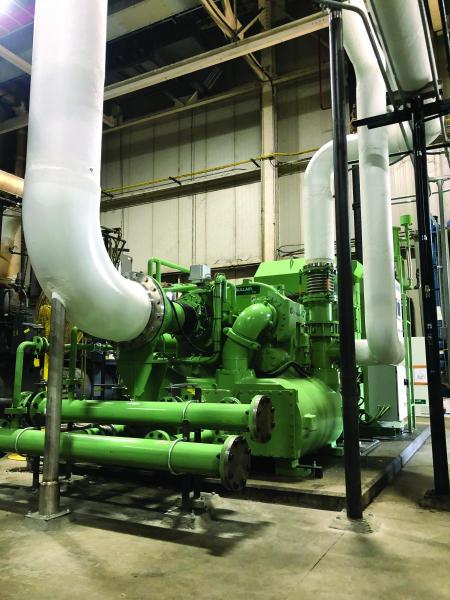
Sullair centrifugal compressor installation at an automotive manufacturer.
Why is oil free important to begin with?
Many industries and applications require clean, dry compressed air – and the best quality of air – to reduce the risk of contamination on compressed air, on the end product and other items throughout the production process.
Even the slightest amount of oil as a contaminant can have damaging effects on these industries—think contaminating end products like food or drinks, damaging production equipment, causing downtime, or damaging your brand’s reputation due to the low quality of the end product and/or product rejections.
Uses of oil free compressed air
Oil free compressed air is most often used in three applications at facilities:
- For process applications – when we say process applications, we mean oxygen content. This is important for pharmaceutical companies, in combustion and with other processes that consume oxygen.
- To control equipment – starting and stopping equipment in facilities is often driven by compressed air
- To power machinery and equipment in the facility
Oil free air compressor options
There is a range of oil free air compressors available on the market from 1.5 psi to 160 psi (pressure rating), and from 10 cfm to more than 5000 cfm (flow). Oil free air compressor options include scroll, single-stage rotary screw, two-stage rotary screw and centrifugal.
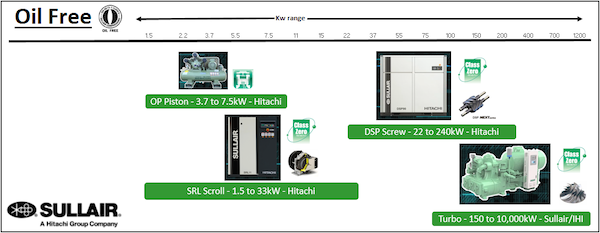
Chart showing which oil free compressor options are available per kW range.
How to size oil free air compressors
Properly sizing an oil free air compressor will determine if your facility will have enough air to power your production equipment. By taking careful consideration and proper planning upfront, you’ll end up with a more effective compressed air system that helps minimize interruptions and downtime.
Choosing the right equipment and determining how the air will be used are important considerations when determining the size of the oil free compressor. If you choose an air compressor too large for your application, you’ll consume more energy than needed. If you choose an air compressor that is too small for your application, it will not deliver the air supply needed for your production. Not only can this impact your production itself, but it will likely result in a need to purchase another compressor to meet the demand, which emphasizes the need to get it right at the start.
How do you go about selecting and sizing oil free air compressors? It involves a few steps:
1. Match compressor type to the required pressure
How much air (CFM) do you need? While it sounds simple, it can cause issues in installations if it’s not done right. Cubic feet per minute (CFM) is how much airflow a compressor can produce, and there are many variables that can affect the performance of the compressor you buy. Understand the CFM demand of your facility during peak times and find a compressor that will deliver the required CFM in your operating environment.
Altitude, room temperature, and humidity – all variables – can significantly derate the capacity of your compressor. Take these into account when making your equipment decisions. If you buy a compressor that is too big, you are wasting money and several maintenance issues can develop over time. If you buy too small, you won’t be able to operate the machines or tools you need to keep your operation humming and the compressors can also develop maintenance issues over time.
2. Determine air quality and what “oil free” means
The International Organization for Standardization (ISO) 8573-1 Air Quality Classes outlines the contaminants allowed by class. Oil free applications require Quality Class 1 at minimum but preferably Class 0. Class 0 air is more stringent than Class 1 (0.01 mg/m³ of oil as contaminant), as agreed upon between the manufacturer and the user.
While Class 1 may be technically acceptable, it comes with risks. Class 1 requires inline filtration to eliminate oil content coming from the compression process. The filtration then depends on two variables directly affecting the performance of the filtration process: compressed air pressure and compressed air temperature/ambient temperature.
3. How much are you using the compressors?
Do you run an operation with one shift? Two shifts? Three shifts? This is an important consideration to determine whether you’ll need one compressor or multiple compressors, as well as how much backup air.
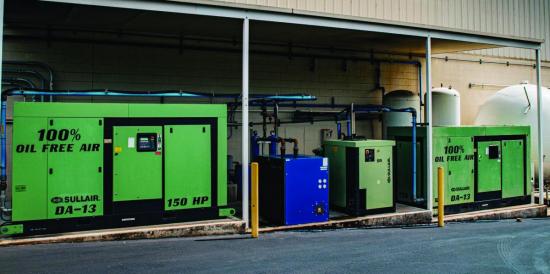
A food processing plant depends on twin 150 hp Sullair DA-13 oil free air compressors.
Maintaining oil free air compressors
Once you’ve properly sized an air compressor and it has been installed, the work isn’t over. To help ensure smooth operations at your facility, and to avoid interruptions and unexpected downtime, it is critical to maintain oil free air compressors. Oil free air compressors require less maintenance but require more care.
Preventative maintenance is crucial, and some of the key components are the most important to inspect and/or clean according to schedule. Most newer oil free compressors can show upcoming maintenance reminders on the controller display based on operating hours and calendar. This makes it easier for end users to plan, schedule downtime, and order needed parts and kits. Maintenance schedules are different, depending on whether you operate less than 4,000 or 8,000 hours per year.
Maintenance Schedules for Dry Screw Air Compressors

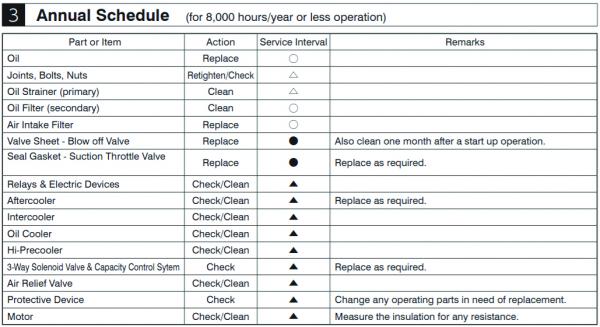
Scroll compressors require maintenance every 2,500 hours. Scroll heads should be maintained every 10,000 hours or 4 years for 122 psi and 5,000 hours or 2 years for 145 psi machines.
Other than daily checks, centrifugal compressors require six monthly and annual preventive maintenance checks to operate at optimum working conditions and avoid any unforeseen downtime.
Many manufacturers and distributors offer service and maintenance plan options to help ensure your oil free air compressor will operate day after day and to its full life expectancy. As anyone who runs an operation knows, downtime is costly.
Service and maintenance plans ensure maintenance is taken care of, genuine parts are used, and factory-trained technicians repair the machines. Working with a service and maintenance plan helps:
- Avoid downtime – Performing maintenance as scheduled helps the compressor run smoothly and more efficiently, thereby decreasing bouts of downtime
- Avoiding costly emergency repairs – Timely and proactive maintenance helps increase profits though increased productivity. If repairs are needed, it’s covered under the plan, keeping maintenance budgets in check.
- Ensure energy savings – When regular maintenance is performed, technicians can identify when a machine is overexerted or underproducing. This is often a first indicator of a part needing replacement or cleaning. When you identify the issue early, energy savings can be realized.
Having a service and maintenance plan is one option to help you avoid unplanned expenses and maintain a well-functioning operation.
Overhaul frequency
Overhauling dry screw oil free machines consists of inspecting and replacing the air end, fan inverter and bearings every 6 years or 48,000 hours.
On scroll compressors, scroll heads need to be overhauled every 20,000 hours, or 8 years of service, for 122 psi and 15,000 hours, or 6 years of service, for 145 psi.
Centrifugal compressors have a simpler design, hence fewer moving parts, but also require an overhaul every 6 years or 48,000 hours of service. This involves dismantling, inspecting for damage and wear and repairing/re-coating of impellers to extend the life of compressor.
Selecting & Sizing Oil-Free Air Compressors – Webinar RecordingDownload the slides and watch the recording of the FREE webcast to learn:
|
How to adjust sizing for different cooling water conditions or different ambient temperatures
Should I go with air-cooled or water-cooled?
When selecting an oil free rotary screw air compressor, there are two cooling configurations to choose from: air-cooled or water-cooled. Air compressors create a lot of heat during their normal operation – up to 90% total electrical energy consumed. The heat primarily comes from the motor, air end and cooling circuit. Users need to choose between an air-cooled or water-cooled compressor, and this decision is based upon the size, location and utilities available to the air compressor.
The reason a customer opts for air-cooled versus water-cooled is often based on their environment, costs of water cooling, if water is available and space considerations.
Air-cooled compressors require adequate amounts of cooling air for the inlet and enough space for discharge. Without enough space, customers may encounter temperature regulation issues which can cause nuisance shutdowns or equipment failures. Ductwork to the inlet and from the discharge typically gets cool air into the compressor package and the discharged hot air can be removed from the plant. In the wintertime, this heat can be directed into the plant to help heat the factory—offering additional savings and improve energy efficiency of the manufacturing facility.
If you have a confined space you’re working with, water-cooled compressors may be a better choice. If the customer’s environment is caustic or extremely dirty, a water-cooled solution may be the best fit. There are many different designs of cooling towers and each has its advantages and disadvantages. Users need to consider the initial cost of the tower plus the energy required and maintenance that goes along with cooling tower designs. Users can also use other sources of cooling water like public supply water, self-supplied well water, river, ocean or lake water. A major consideration when using a natural water supply is the cleanup of the water once it passes through the compressor. Chilled water is also a consideration if the customer has this type of equipment, but often this is avoided due to the high costs associated with chilled water systems.
If opting for water-cooled, the water can be used for other hot water applications, where you reclaim the heat. Water-cooled air compressors allow for most of the heat from compressors to be reclaimed.
Depending on your geography – say you’re in a colder climate – if you use cooling water, you could then use that water for various applications, such as in the boiler room or for other manufacturing applications. In times where every penny is important in an operating environment, this is an additional way to realize savings.
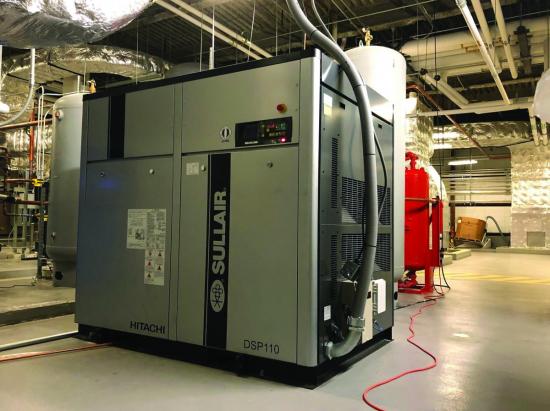
Sullair DSP Series oil free rotary screw compressor installation at a pharmaceutical manufacturing plant.
What about different ambient conditions?
Based on ambient conditions, you need to oversize the air compressor to compensate for higher cooling requirements and high temperature shutdowns. The most common oil free ambient condition is 40° C. Some compressors are smart and can reduce output by 3 to 9% and continue to operate above rated ambient temperatures. Reduced output is better than no output when the air requirements can be distributed to other compressors in the facility or backup compressors.
How to set up compressed air purification systems (including heat of compression dryers) after the air compressor
While oil free compressors eliminate oil that would otherwise need to be removed from compressed air if you used an oil flooded compressor, oil free air compressors do not have the ability to reduce many of the other contaminants typically present. This includes water (moisture).
To ensure processes and end applications are not affected by water (moisture), it is necessary to remove or reduce them to an acceptable level. This is where heat of compression comes into play, to ensure air that is clean and dry, up to -70° F dewpoint. Some of the regenerative or desiccant dryers will need to accommodate for 15-20% of additional capacity to allow for purge air to recharge the desiccants in the dryer. Through proper dryer selection, this purge air wastage can be saved.
Conclusion
There are many considerations when selecting on oil free rotary screw air compressor. It is always best to consult your local compressed air expert to determine what best suits your facility. They will better understand the needs and recommend a reliable and a long-term oil free air system solution.
About the Author
Navendu (Nav) Sharma is the Senior Global Oil Free Product Manager for Sullair. He joined Sullair in 2014 and previously served as a senior product manager for portable air compressors. Throughout his career, Nav has also served in quality, product development, and program management roles within the manufacturing industry. Nav may be reached at navendu.sharma@sullair.com.
About Sullair
Sullair, founded in Michigan City, Indiana, in 1965, is a leading global provider of compressed air solutions. The company was one of the first to execute rotary screw technology in air compressors, and its machines are known throughout the world for their reliability, durability and performance. Sullair became a Hitachi Group Company in July 2017. For more information, visit www.sullair.com/oilfree.
To read similar Air Compressor Technology articles visit www.airbestpractices.com/technology/air-compressors.
To read similar Food Industry articles, visit www.airbestpractices.com/industries/food.




